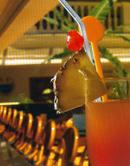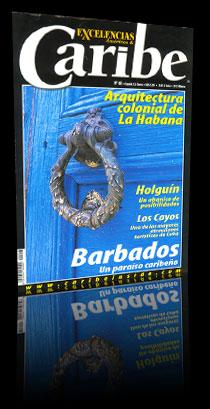The Caribbean and thirst-quenching cocktails
Back in the 1930s, the smoldering Caribbean heat had prompted a well-built American with a taste for drinks with kicks in them to swing by a couple of his favorite hangouts in the Cuban capital to guzzle –rather than the usual scotch or whiskey- a mixture of sugar, juices and aromatic leaves dipped in rum.
Ernest Hemingway used to make a routine walk from the Ambos Mundos Hotel (Both Worlds), right in the heart of Old Havana, all the way to his favorite spots: La Bodeguita del Medio and El Floridita. Today, these are two world-known restaurants and their fame is widely owed to these two flagship drinks of Cuba's finest cocktail-making: mojito and daiquiri.
Both drinks are the undisputed heavyweights of Cuba's wide survey of cocktails, and the two of them are based on Cuban-made rum, a genuine spirit used in an assortment of drinks all across the Caribbean for its high concentration of alcohol that allows any imaginable blend without losing its exquisite flavor and punch.
That explains why rum is no doubt a great liquor for drinking all year round, especially in hot-weather countries where its refreshing and peerless flavor combines harmoniously with such fruits as mangoes, guavas, pineapples, coconuts and bananas, yet keeping its strong identity unscathed.
This is nothing but a distilled alcoholic beverage churned out of the molasses of sugarcane, an Asian-origin plant that Spaniards brought to the island nation circa 1500 to spread it all over the so-called New World.
In the 18th century, though, word about a kind of beverage brewed by residents of the West Indies and powerful enough to cause some topsy-turvy effects started making the rounds. At the time, people knew it by the name of tafia and it was the result of the fermented sugarcane juice that African slaves (major workforce in sugarcane plantations then) also nicknamed guarapo, for it reminded them of the guarapa, an African homemade beverage.
Pirates were great rum smugglers and eventually took the spirit all around the Caribbean Basin. During the 17th and 18th centuries, rum used to be shipped to Europe and the United States. The unstoppable demand for this new product prodded businesspeople to found a couple of distilleries in New York and New England. For many, rum is now the perfect companion for any occasion, whether in times of sorrow and pain, or for nightlong parties. Either way, the presence of this beverage, sired by sugarcane not far from the sea, is undying.
In producing countries, residents usually knock it back straight or on the rocks, but cocktail blends are highly coveted. A case in point is the Piña Colada –a mixture of rum, coconut crème and pineapple juice. Other combinations include rum and tomato juice with a pinch of salt and pepper to underscore the flavor, and the divine spirit mixed with any fruit juice.
NO HARD DRINKS, PLEASE For those who seek refreshing drinks with no alcohol, the Caribbean also offers a variety of combinations to choose from. And in this particular realm nothing compares to a Fruit Punch, so commonplace on the islands.
Served in an array of ways, the well-known Fruit Punch is a fusion of uplifting fruits that make perfect treats in this neck of the woods.
Pineapple, orange or lemon juice with a tad of grenadine and sugar, altogether in a tumbler with abundant ice, is a gift for the senses when the sun beats down on travelers mercilessly.
The abovementioned guarapo –squeezed out of sugarcane pulp and served with plenty of ice- is another great choice.
There are also some native creations worth mentioning here such as the mabi in the Dominican Republic which is made of the stem of the Goanina lupuloide, an Indian twig that –experts claim- contains sapponine, a chemical that help do away with free radicals and makes a great diuretic and stomach tonic. With an aged and invigorating flavor, the mabi is the king of the Dominican home and a longstanding complement for families needed to make ends meet.
A similar kind of drink exists in Barbados –the mauby- a nonalcoholic beverage brewed after boiling the aforesaid stem together with sour spices. The content is then sieved and the resulting mixture is sweetened. Cubans, for their part, swig pru, based on fermented vegetable roots and herbs exclusively found on the eastern part of the country.


































































